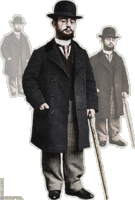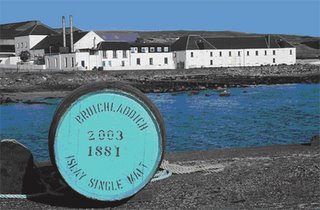
As his charcoal stick danced across the cloth napkin, capturing the slants and curves of the nightclub dancers and their lusty followers, the little man in the bowler hat began working faster and faster.
His vivid portraits of freewheeling cafe life leapt off the impromptu canvas, at once bold and graceful, revealing and enigmatic, acting as a guide for his later versions done in colorful oils.
A body of work fueled by a creative fire, of course, but perhaps just as much by frequent sips of the pale green liquid ever present on his table.
Such is the legend of the tragic 19th century artist Henri Toulouse-Lautrec (above), portrayed as a brilliant artist but a tortured alcoholic in several "Moulin Rouge" films and countless biographies.
While the work of Lautrec (1864-1901) lives on, his drink of choice -- absinthe -- receded into dim memory after it was banned throughout much of Europe and the United States around the time of World War I.
Absinthe, an herb-infused alcohol that began as a medicine, had been blamed for bad judgment, poor health, even outright madness. Nevertheless, it was the drink beloved of 19th century Parisian cafe society, enjoyed by such writers and artists as Baudelaire, Lautrec, Picasso, Degas and Manet. In fact, in those times the cocktail hour was referred to as l'heure verte -- the green hour -- in honor of absinthe.
There are those who theorize that the anti-absinthe forces were funded by the wine industry, which was losing ground in the marketplace to the "Green Fairy," as the drink was known. Any link, no matter how tenuous, between evildoers and absinthe was loudly proclaimed until enough of the public grew fearful of its continued availability to demand a ban.
Absinthe began its comeback several years ago in England, where entrepreneurs discovered no legal ban remained in effect prohibiting sale or consumption of absinthe. Its availability has spread to neighboring countries and even to the U.S., although consumption here is limited by the federal government's guidelines against the original-strength version.
Ted Breaux, a New Orleans chemist and microbiologist, has replicated the recipe used by Edouard Pernod for the premier absinthe of that Parisian heyday. According to the chemistry newsletter from England's Oxford University, "Breaux has spent seven years studying absinthe ... (He) owns two bottles of century-old premium Pernod's, which greatly facilitated his efforts. Breaux's absinthe, soon to be commercialized outside of the U.S., is believed by many to be the finest the world has seen since 1915."
Absinthe is made by steeping dried herbs in ethyl alcohol, then distilling the liquor. The main herbs are nothing unusual … anise and star anise, peppermint, wormwood, fennel, perhaps a few others, depending upon which recipe one prefers. Wormwood is the catalyst for a chemical change during the process that, combined with the very high alcohol content (usually in excess of 150 proof, or 75 percent), gives the drink its potency through release of the chemical thujone.
Absinthe today is manufactured primarily in Spain, the Czech Republic and France, the latter on a very limited basis. (It also is a popular bootleg product in Switzerland, with an estimated 15,000 gallons turned out annually, virtually all for domestic consumption.)
Hill's Absinthe, Deva Absenta and Pernod-Ricard -- the great-granddaddy of them all -- are the major brands. Although technically above the permissible U.S. strength, they are not impossible to buy domestically in very limited quantities. If you can't find them locally, you can always try ordering them through your favorite liquor store, or through an online source.
A no-strings-attached modern American version of absinthe is Absente, priced at about $40 and testing out at a comparatively moderate -- by absinthe standards -- 110 proof. It's also referred to as "petite absinthe" because of its lowered potency.
The federal government frowns on the original strength absinthe because it contains a high level of thujone. Thujone is believed to be the culprit in the bad things one hears about absinthe, although historically much of the mayhem and madness blamed on it doesn't hold up under scrutiny.
Wormwood itself is not inherently bad. It has been used as a medicine for stomach ailments and as an herbal dietary supplement. Its medicinal uses crop up regularly in the Bible. The problem comes with the concentration ingested.
The Absente brand maintains the distinctive flavor by using the milder southern wormwood, which has a much lower thujone content than the 10 parts per million maximum dictated by federal law. In its heyday, original-style absinthe measured in the range of 30 or more.
Whether excessive consumption of absinthe produces murderous rages, melancholy ruminations or just a mild dysphoria remains up for debate. Even one of its most ardent admirers, the Irish writer Oscar Wilde (1854-1900), was ambivalent on the subject. As he wrote on two different occasions:
"A glass of absinthe is as poetical as anything in the world. What difference is there between a glass of absinthe and a sunset?"
And:
"After the first glass, you see things as you wish they were. After the second, you see things as they are not. Finally, you see things as they really are, and that is the most horrible thing in the world."
To Dowd's Spirits Notebook latest entry.
To Dowd's Wine Notebook latest entry.
To Dowd's Brews Notebook latest entry.
Back to Dowd's Bar Blog home page.









